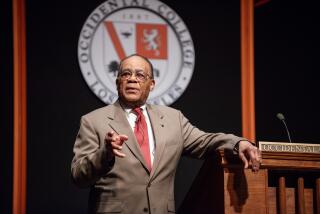Marian Diamond dies at 90; scientist studied Einstein’s brain and helped unlock secrets of the mind
Marian Cleeves Diamond, a UC Berkeley neuroscientist who studied Albert Einstein’s brain and was one of the first to show that the brain can improve with enrichment and intellectual stimulation, has died.
The school, where Diamond was a professor emerita of integrative biology, confirmed that Diamond died at her home in Oakland on July 25. She was 90.
In 1984, after receiving four pieces of Einstein’s preserved brain, Diamond discovered that it had more cells known as support cells than an average brain.
In her work with rats she showed that an enriched environment — characterized by toys and companions — changed the anatomy of the brain.
She found that the brains of all animals, including humans, benefit from an enriched environment, and that impoverished environments can lower the capacity to learn.
“Her research demonstrated the impact of enrichment on brain development — a simple but powerful new understanding that has literally changed the world, from how we think about ourselves to how we raise our children,” said UC Berkeley colleague George Brooks, a professor of integrative biology.
Her findings were initially resisted by some neuroscientists. At one meeting, Diamond later recalled, a man stood up after her talk and said loudly, “Young lady, that brain cannot change!”
Diamond said she knew better than to be put off by such a response.
“It was an uphill battle for women scientists then — even more than now — and people at scientific conferences are often terribly critical,” she wrote in her 1998 book “Magic Trees of the Mind: How to Nurture Your Child’s Intelligence, Creativity, and Healthy Emotions From Birth Through Adolescence,” co-authored with Janet Hopson.
“But I felt good about the work, and I simply replied, ‘I’m sorry, sir, but we have the initial experiment and the replication experiment that shows it can.’”
Born in Glendale on Nov. 11, 1926, Diamond attended Glendale Community College before transferring to Berkeley, where she went on to earn her doctorate. She was a research assistant at Harvard University and the first woman science professor at Cornell University, where she taught biology and comparative anatomy. She returned to Berkeley as a lecturer in 1960.
Her career at Berkeley ended up spanning half a century.
For decades she could be seen walking through campus to her anatomy class carrying a flowered hat box — with a preserved human brain inside.
In her typically packed classes, she would gently lift the brain from its wrapping and express awe that such a small, three-pound mass of protoplasm was the most complex structure known to humankind.
Diamond is survived by four children, Catherine Theresa Diamond, Richard Cleeves Diamond, Jeff Barja Diamond and Ann Diamond. She was proceeded in death by her husband, Arnold Scheibel.
A Times staff writer contributed to this report.
More to Read
Start your day right
Sign up for Essential California for the L.A. Times biggest news, features and recommendations in your inbox six days a week.
You may occasionally receive promotional content from the Los Angeles Times.






